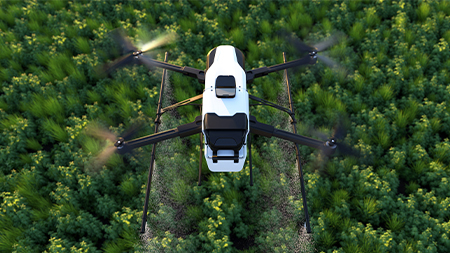We are creative, ambitious and ready for challenges! Hire Us
Farming Automation
- Home
- Farming Automation

Farmers can keep an eye on their fields from anywhere.
Farming Automation is designed to help farmers close the supply-demand gap by ensuring high yields, profitability, and environmental protection. The use of IoT technology to ensure the most efficient use of resources in order to increase crop yields while lowering operating costs. Specialized equipment, wireless connectivity, software, and IT services are all part of farming automation in agriculture.

Farming Automation has the potential to transform agriculture in several key areas
Smart agriculture sensors collect data –
Sensors, control systems, robotics, autonomous vehicles, automated hardware, variable rate technology, motion detectors, button cameras, and wearable devices are all important components of this approach. Information collected on these systems can be used to track the overall strength of the crops as well as workforce performance and equipment efficiency. This enables the ability to predict production rates and allows farmers to better plan their production and supply.
Agricultural Drones –
Drones are being used in agriculture to improve a variety of agricultural practices, including crop health assessment, irrigation, crop monitoring, crop spraying, planting, and soil and field analysis.
Livestock tracking and geofencing –
Farm owners can collect data about their cattle’s location, well-being, and health using wireless IoT applications. This information helps in disease prevention as well as labor cost reduction.
Machine Navigation –
Tractors and heavy ploughing equipment can be run automatically from the comfort of your own home using GPS, just like remote-controlled toy cars. These integrated automatic machines are extremely accurate and self-adjust when terrain differences are detected, making labor-intensive tasks easier to complete. Smartphones make it simple to track their movements and work progress.
Remote Sensing –
Data from sensors installed on farms, such as weather stations, is collected and sent to analytical tools for analysis using IoT-based remote sensing. Sensors are electronic devices that detect malfunctions. Farmers can use the analytical dashboard to monitor their crops and take appropriate action based on what they learn.
1. Crop Inspection
Sensors installed along with the farmlands track changes in light, humidity, temperature, shape, and size of the crops. Any anomaly found by the sensors is investigated, and the farmer is notified. As a result, remote sensing can aid in disease prevention and crop growth monitoring.
2. Climate conditions
The data collected by sensors in terms of humidity, temperature, moisture precipitation, and dew detection help in determining weather patterns in farms so that appropriate crops can be cultivated.
3. Soil Quality
Soil health analysis helps in examining the nutrient value and drier areas of farms, as well as soil drainage capacity and acidity, allowing for adjustments in the amount of water required for irrigation and figuring out the best type of cultivation.
Benefits of Farming Automation
1. Production Insights and Real-Time Data
2. Reduced Operating Costs
3. Increased Production Quality
4. Accurate Farm and Field Assessment
5. Improved Livestock Production
6. Remote monitoring
7. Equipment monitoring
How simple is it to use Farming Automation?
In agriculture, it is a technology that combines sensitive physical hardware with analytical software. Analytical dashboards are primarily software that processes data collected by the equipment. As a result, a simple technical understanding of robotics and computer-based intelligence is required to operate, maintain, and comprehend the insights of this valuable machinery.








